Radiant Sri Puri Jagannath Temple: The Lord of the Universe
Sri Puri Jagannath Temple is one of the famous and sacred temples belonging to Lord Jagannath. It is a place where ancient rituals and cultures were followed. Here we find trinity gods in the form of Jagannath, Bala Bhadra, goddess Subhadra, and Sudarshan Chakra. The Jagannath temple was built in the 12th century A.D. by King Ananta Burman Chodaganga Dev.
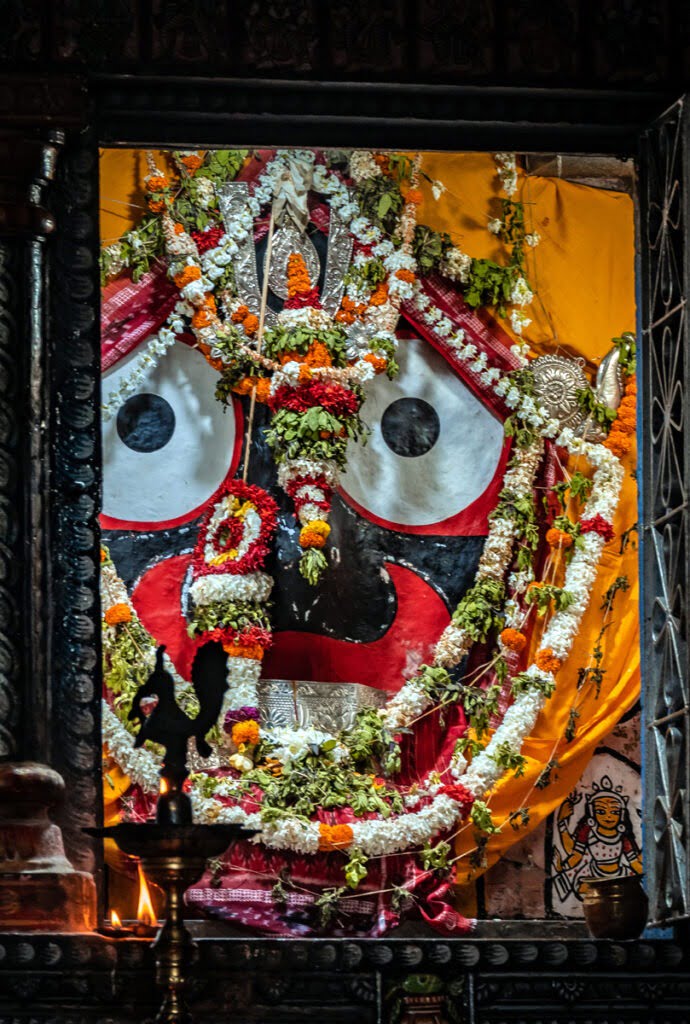
As we are all aware India is a country where many kings ruled, here we find their presence and their style of worship even today. This temple is located in the city of Puri on the branches of the river. Sri Puri Jagannath Temple is not only known for its architecture but also for its natural beauty.
“ sarvam rahasyam purusottamasya Devonajanati kuto manusya”
The above sloka is one of the ancient Sanskrit slokas which means, He is the lord of the universe, and he is immortal and remains a mystery. He is the supreme among mankind.
Sri Puri Jagannath Temple is filled with many secrets and mysteries. Usually, we find idols made of metal or stone but here idols are made with wood (neem logs referred to as Daru Brahma). For every 12 years, these idols are ceremoniously replaced by another wooden replica. Hindus treat this as a new embodiment but the exact reason behind this ritual still remains secret. Lord Jagannath is being noted in many ancient texts like Agni Puran, Brahma Purana, brahmana Puran, etc.
Devotes who come here have a holy bath and visit nearby shops to purchase items that are liked by the lord. Then enter the main entrance where you find Dwajastambam. Whoever devotee sees dwajastambam of Puri Jagannath is considered to see the lord directly. Sri Puri Jagannath Temple is an amalgamation of different temples, here we find Lord Vishnu, Lord Shiva, and goddess Shakti.
We find the sacred mantra “Om namo jagannatha swamiye namaha” is being spelled by all devotees while entering the main temple, we find 22 steps which we call Bahise Sahocha.
Every year there is be Ratha yatra (Chariot festival) which is considered to be one of the biggest Ratha yatras in India. This is done during the 2nd day of Aashada masa, Sukla Paksha. During Ratha yatra, sacred idols are being bought from the temple and placed them on their allotted ratha with the process of Pahundi by making idols move front and back.
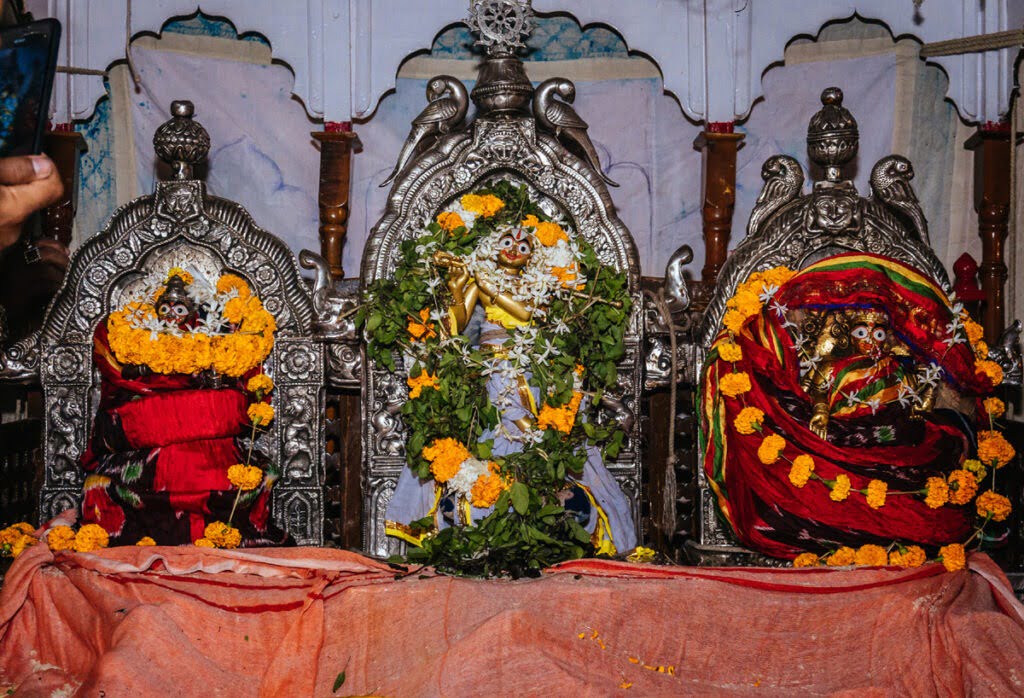
Contents
A Few interesting facts about the Sri Puri Jagannath Temple:
- The flag atop always flaps in the opposite direction of the air
- Sudharshan chakra present on the top will always face you wherever the place you stand in the city of Puri
- On every seashore, air comes from the seashore to land during the daytime and vice versa during the night. But here it is quite the opposite.
- Never a bird or flight flies above the Sri Puri Jagannath Temple.
- You will not be able to see the shadow of the main dome at any point of the day.
- The quantity of food cooked remains the same throughout the year which is aimed to serve 20 lakh devotees. Even at times of surplus devotees, or decrease in devotees, there is no record of shortfall of prasad or wastage
- In the temple kitchen, there are 7 pots that are placed on one another and cooked on firewood. During the process of cooking always top pot gets cooked first and the pots are cooked in descending order.
Sri Puri Jagannath Ratha Yatra:
Sri Puri Jagannath Ratha Yatra is the annual Hindu festival taken out in Puri City, India. On this festival, devotees recall the annual procession of three presiding deities-the presiding deities being the trio of Lord Jagannath, his sibling sister Balabhadra and her sister, Goddess Subhadra from their place, Jagannath temple.
The festival starts with the decoration of three big chariots. In the chariot, flowers and flags, as well as other types of ornamentations are used to decorate the chariot. Then on this day, gods from the temple are brought out to the chariot, thousands of devotees sit with them, and then ride on it through all areas of the city of Puri.
Perhaps, Ratha Yatra is one of the most fantastic religious and cultural events that can be seen in this world. Millions of devotees around the globe attend this festival. All faith, love, and community.
This festival happens for five days. On the first day, during Pahandi, deities of the temple come out and are placed inside chariots. Bahuda Yatra is the second day wherein chariots are taken out from Jagannath Temple to Gundicha Temple. The third day is Niladri Bije which happens when deities go back to the Jagannath Temple. On the fourth day, Chandan Yatra is followed wherein deities are applied with sandalwood paste. Ulta Ratha Yatra-On the fifth day, wherein the chariots go back to the Jagannath temple in reverse order..
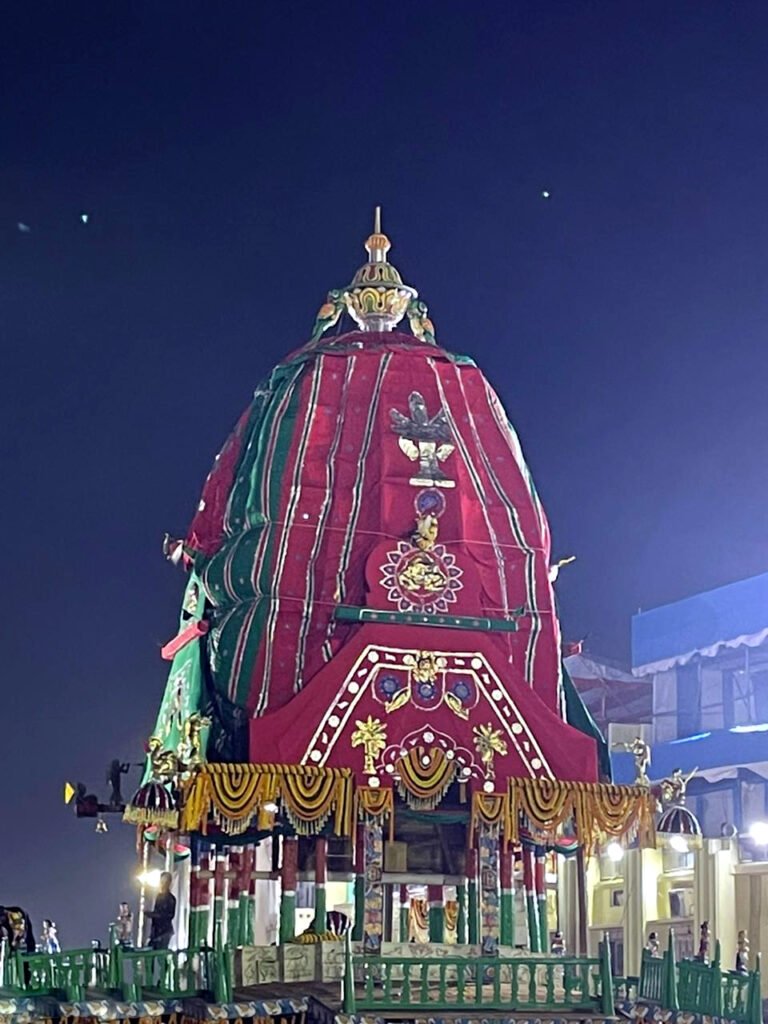
Architecture of Sri Puri Jagannath Temple:
The term applied to the major temple construction is the “Deula”. It forms a highly raised platform tower, and it is accompanied by an outer wall, which is very high. The stone temple of Sri Puri Jagannath is around 214 feet tall. This is roughly 65 meters.
Sikha or spire: At the temple complex, Sikha or spire holds a vital integral position. In the shape of pyramid, it is made out of sandstone. Decoration through carvings and sculptures has been done over the garbhagriha or sanctum sanctorum.
Jagamohan (Mukhasala): This is the main assembly hall or porch of the principal temple. It is of pyramidal shape, and also known as Mukhasala. The garbhagriha – the inner sanctum of jagamohan – is a part of this building which houses the deity.
Vimana: That part of the temple which forms the sanctum sanctorum of the temple has been used for worshiping the deity Lord Jagannath. A small windowless pyramidal roofed structure makes it.
Along with the main shrine are there some pillared halls and mandapas that forms mandapa wherein several religious rituals, gathering, even the resting place of pilgrims.
Sri Puri Jagannath Temple is famous for stone carvings as well as sculpture. In it, various scenes of the Hindu mythological themes that occur within the carvings and sculptures like Mahabharata, Ramayana, besides motifs, and various gods and goddesses are described.
LİNGARAJA STYLE : Architecture of the Shree Puri Jagannath temple is called as the style of Kalinga, or Lingaraja, which is featured with their unique spire, used sandstone.
FLAG WITH FLAGSTAFF : As a ritual at the head of the temple spire, there are two rituals: the Patitapavana Bana that denotes the flag, and there is a flagstaff of Dwaja Stambha and is changed every day.
The high walls around the temple have many gates for entrance. This temple is accessed only by Hindus.
Lingam and Yoni: Before the main door of the temple, there is a pillar which is a sacred one called the Aruna Stambha. This pillar indicates the Lingam and Yoni and is considered as the symbol of Lord Shiva.
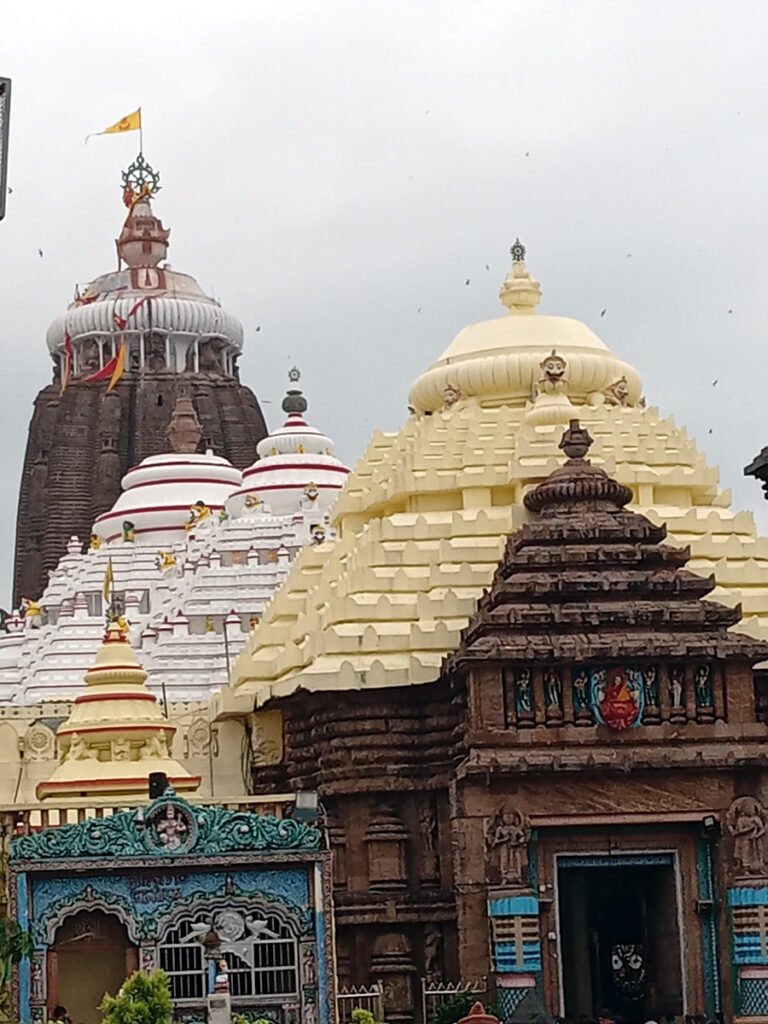
Places to visit near Sri Puri Jagannath Temple:
Konark Sun Temple: This monument is a UNESCO World Heritage and lies almost 35 km from the city of Puri, to which it is a neighbor. It is built with fine carvings on its stones for god Surya.
Chilika Lake: It is a great place to sit and observe migratory birds and dolphins; boat rides can be taken there. It is one of the Asia’s largest coastal lagoons just 35 km away from Puri.
Puri Beach: The best place for a traveler to visit in Puri. One can take leisure walks or indulge in endless number of water sports keeping little break at the coast of seashore.
Raghurajpur: Pattachitra paintings and classical Odissi dance here, heritage crafts village about 14 kilometers from Puri where much more can be delved into the region’s arts and culture.
Sakhigopal Temple: This temple associated with Lord Krishna is about 20 km from Puri. Here, good architecture is seen along with religious importance, and it is also a place of pilgrimage.
An hour’s drive to the east of Puri lies the capital city of Odisha-Bhubaneswar. The most famous of the several temples it boasts of is the Lingaraj Temple dedicated to Lord Shiva. Besides these, numerous ancient temples dot the skyline of the city.
It is 30 km from Puri, Odisha and dates back to the 2nd century BCE; the caves are excellent examples of cave rocks carved out into some extensive extents with intricate cuts and inscriptions.
Dhauli Hill: About 30 km from Puri it is said that after Kalinga war, it was from the body that Ashoka took birth in the form of a Buddha. On this rock in the place sits the Peace Pagoda alongside some inscriptions engraved.
Ratnagiri and Udayagiri Buddhist Complex : About 70 kms from Puri, lie ancient Buddhist complexes which are greatly in fashion, when it comes to sculputural finds, among the fraternity of the Buddhists as well as the scientific fraternity, from the point of view of archaeology and anthropology.
Satpada: Satpada or 50-km-distance from Puri acts as an entrance toward the Chilika Lake and is in a celebration of beauty of landscapes as also boating services.
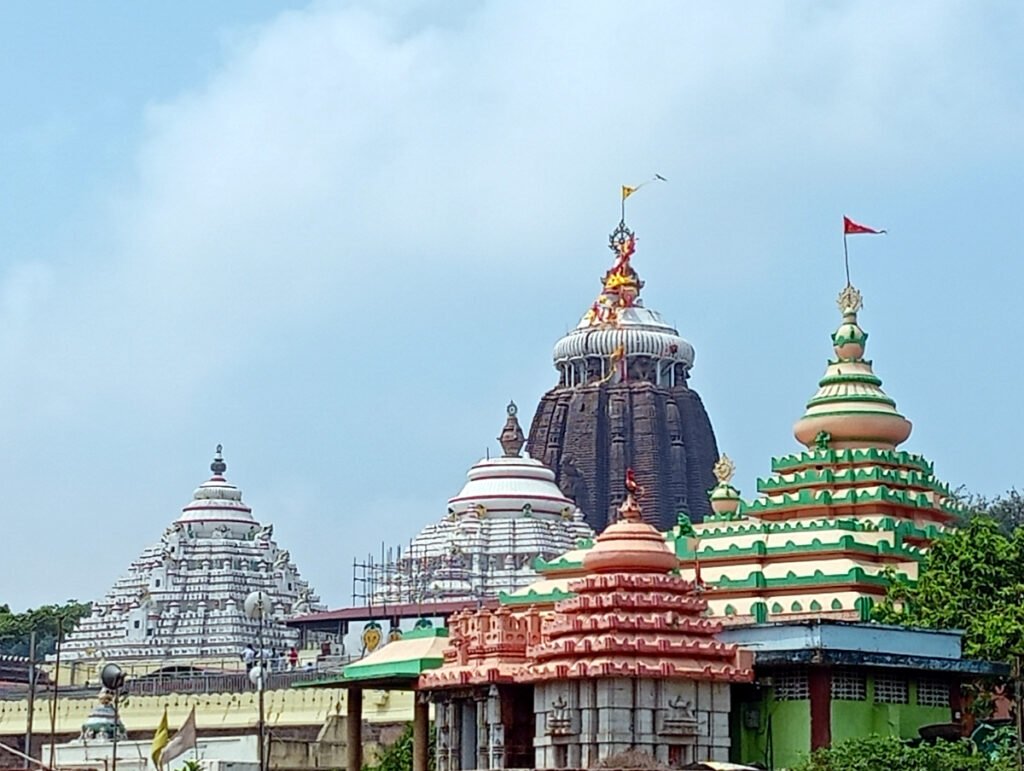
How to reach Sri Puri Jagannath Temple:
By Air: The nearest airport is Biju Patnaik International Airport in Bhubaneswar.
Distance: Approx. 60 kilometers away from Sri Puri Jagannath Temple.
By Train: Puri Railway Station.
Accommodation near Sri Puri Jagannatha Temple:
Shree Jagannatha Temple Administration Guest Houses:
These provide basic lodging at reasonable prices. You can book directly from their website or from the office of the temple administration at Puri.
Dharamshalas and Ashrams:
Most of the religious institutions in Puri offer affordable lodging facilities to devotees. These are usually simple rooming facilities with shared restrooms.
Hotels Near the Temple:
There are various hotels in walking distance of the temple. These hotels are very comfortable, along with air conditioning, Wi-Fi, and attached bathroom amenities.
